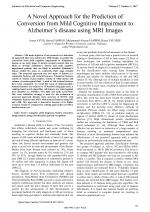| 2/2017 - 15 |
A Novel Approach for the Prediction of Conversion from Mild Cognitive Impairment to Alzheimer's disease using MRI ImagesAYUB, A. |
| View the paper record and citations in |
| Click to see author's profile in |
| Download PDF |
Author keywords
computer aided diagnosis, feature extraction, image analysis, image classification, pattern recognition
References keywords
alzheimer(34), disease(29), classification(20), brain(14), neuroimage(13), cognitive(13), structural(12), mild(12), impairment(12), pattern(11)
Blue keywords are present in both the references section and the paper title.
About this article
Date of Publication: 2017-05-31
Volume 17, Issue 2, Year 2017, On page(s): 113 - 122
ISSN: 1582-7445, e-ISSN: 1844-7600
Digital Object Identifier: 10.4316/AECE.2017.02015
Web of Science Accession Number: 000405378100015
SCOPUS ID: 85020067022
Abstract
The main objective of our research is to introduce an approach that uses noninvasive MRI images to predict the conversion from mild cognitive impairment to Alzheimer's disease at an early stage. It detects normal controls that are likely to develop Alzheimer's disease and mild cognitive impairment patients that are likely to establish Alzheimer's disease within two years or, contrarily, their stage remains same. The proposed approach uses two types of features i.e. volumetric features and textural features. Volumetric features consist of volume of grey matter, volume of white matter and volume of cerebrospinal fluid. A total of 364 textural features have been calculated. To avoid the curse of dimensionality, textural features are reduced to 15 features using gain ratio, a ranking based search algorithm. All features are tested against four classifiers i.e. AODEsr, VFI, RBF and LBR. Leave-One-Out cross validation strategy is used for the evaluation of proposed approach. Results show accuracy of 98.33% with volumetric features and 100% with textural features using VFI and LBR. Our approach is innovative because of its higher accuracy results as compared to existing approaches yet with a smaller feature set. |
| References | | | Cited By |
Web of Science® Times Cited: 3 [View]
View record in Web of Science® [View]
View Related Records® [View]
Updated today
SCOPUS® Times Cited: 4
View record in SCOPUS® [Free preview]
View citations in SCOPUS® [Free preview]
[1] Diagnosis of Alzheimer's Disease from Brain Magnetic Resonance Imaging Images using Deep Learning Algorithms, SUGANTHE, R. C., LATHA, R. S., GEETHA, M., SREEKANTH, G. R., Advances in Electrical and Computer Engineering, ISSN 1582-7445, Issue 3, Volume 20, 2020.
Digital Object Identifier: 10.4316/AECE.2020.03007 [CrossRef] [Full text]
[2] Can neurocognitive assessment be a lower-cost substitute for biomarkers in predicting progression from mild cognitive impairment (MCI) to Alzheimer’s disease (AD)? A narrative review, Daou, Lea, El Alayli, Alaeddine, Constantinos, Fadi, Dib, Georgette, Barakat, Marc, Biomarkers in Neuropsychiatry, ISSN 2666-1446, Issue , 2023.
Digital Object Identifier: 10.1016/j.bionps.2023.100069 [CrossRef]
[3] Convolutional Neural Network Based Prediction of Conversion from Mild Cognitive Impairment to Alzheimer's Disease: A Technique using Hippocampus Extracted from MRI, MUKHTAR, G., FARHAN, S., Advances in Electrical and Computer Engineering, ISSN 1582-7445, Issue 2, Volume 20, 2020.
Digital Object Identifier: 10.4316/AECE.2020.02013 [CrossRef] [Full text]
[4] Neuroimaging and machine learning for studying the pathways from mild cognitive impairment to alzheimer’s disease: a systematic review, Ahmadzadeh, Maryam, Christie, Gregory J., Cosco, Theodore D., Arab, Ali, Mansouri, Mehrdad, Wagner, Kevin R., DiPaola, Steve, Moreno, Sylvain, BMC Neurology, ISSN 1471-2377, Issue 1, Volume 23, 2023.
Digital Object Identifier: 10.1186/s12883-023-03323-2 [CrossRef]
Disclaimer: All information displayed above was retrieved by using remote connections to respective databases. For the best user experience, we update all data by using background processes, and use caches in order to reduce the load on the servers we retrieve the information from. As we have no control on the availability of the database servers and sometimes the Internet connectivity may be affected, we do not guarantee the information is correct or complete. For the most accurate data, please always consult the database sites directly. Some external links require authentication or an institutional subscription.
Web of Science® is a registered trademark of Clarivate Analytics, Scopus® is a registered trademark of Elsevier B.V., other product names, company names, brand names, trademarks and logos are the property of their respective owners.
Faculty of Electrical Engineering and Computer Science
Stefan cel Mare University of Suceava, Romania
All rights reserved: Advances in Electrical and Computer Engineering is a registered trademark of the Stefan cel Mare University of Suceava. No part of this publication may be reproduced, stored in a retrieval system, photocopied, recorded or archived, without the written permission from the Editor. When authors submit their papers for publication, they agree that the copyright for their article be transferred to the Faculty of Electrical Engineering and Computer Science, Stefan cel Mare University of Suceava, Romania, if and only if the articles are accepted for publication. The copyright covers the exclusive rights to reproduce and distribute the article, including reprints and translations.
Permission for other use: The copyright owner's consent does not extend to copying for general distribution, for promotion, for creating new works, or for resale. Specific written permission must be obtained from the Editor for such copying. Direct linking to files hosted on this website is strictly prohibited.
Disclaimer: Whilst every effort is made by the publishers and editorial board to see that no inaccurate or misleading data, opinions or statements appear in this journal, they wish to make it clear that all information and opinions formulated in the articles, as well as linguistic accuracy, are the sole responsibility of the author.





